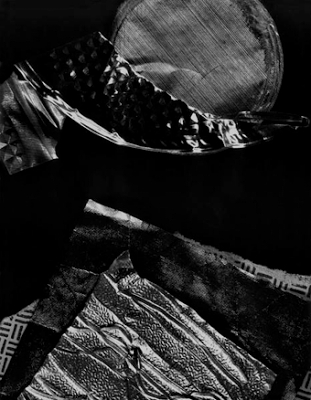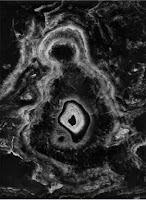Transmutation:
Turning
detritus into splendor
Photo Technique, November/December 2012
Chiarenza’s luminous, meticulously crafted black and white photographs remove his subject from the everyday world of color. This allows his images to transcend their specific subject matter and evoke an inner state of consciousness that grapples with his subject matter beyond its external structure. Chiarenza’s spirit of experimentation disrupts customary expectations through his use of everyday materials to visualize their metamorphosis into hauntingly beautiful abstractions that hint at horizons, geological strata, and quixotic figures. His constructed meditative symbols forge a connection between the mind and nature that elicits emotional responses. This work, often relating to the landscape, dismantles formal media boundaries and permits photography to merge with graphic design, painting and sculpture. Conceptually, Chiarenza’s transformative imagemaking pulls back the photographic cloak to reveal its illusional qualities. In turn, this draws attention to the difference between a photograph and the reality it depicts, reminding us that all photographs are constructed images and not concrete realities. Ultimately, Chiarenza’s work invites psychological speculation by encouraging us to examine the unconscious and/or the subliminal workings of the mind, thus demonstrating how knowledge about our world and ourselves can be gleaned through a fabricated methodology. Chiarenza is also a photo-historian noted for his acclaimed biography, Aaron Siskind: Pleasures and Terrors (1982).
Robert
Hirsch: How did you get interested in photography?
Carl
Chiarenza: The playground across the street from our house in Rochester, NY had
a meeting and storage shack. When I was eight years old I made my first
pictures of neighborhood kids playing ball with a Kodak Brownie. I processed
them in a tiny darkroom the playground director built in that shack. My first
serious picture was of a Rochester East High School wall on graduation day
1953, upon which people had scribbled their names over the years. It was
essentially my first abstract picture.
RH: What is the key visual theme running through your work?
CC: In high school I was already leaning towards a formalistic picture. When I
started attending Rochester Institute of Technology and making photographs for
assignments Minor White gave us, I found myself doing close-ups. This furthered
my interest in abstraction which can be seen in my 1957 senior thesis,
Interaction: Visual Verbal, which essentially consists of close-ups and details
of a railroad yard (facsimile edition available from Nazraeli Press).
RH:
How did your notion of the landscape evolve from outside to inside?
CC:
I have always been attracted to the landscape and tried hard to photograph
outdoors, but I couldn’t get the pictorial ideas to evolve in nature. So I went
into the studio and tried to let collage and light dream up images of my
feelings for and about nature. Later, in 1983, I was invited to participate in
an exhibition called Arboretum for which I made a series of collage pictures
called Woods, which more directly explored my feelings about nature. I
concluded that the idea of landscape is really a pictorial construction. In the
past, people didn’t refer to nature as the landscape out there. It only became
a landscape after it was pictured. My sense of landscape, therefore, is that it
is an abstract, emotional, pictorial mindset that we construct to examine
nature in relation to ourselves. Nature is not picturesque,
it is often ugly and unruly, which is why one has to struggle to make a
photograph out
in it. By working in the studio, I have control over the light and its effect
on the collage. This allows me to alter that relationship in a manner similar
to how I burn and dodge in the darkroom.
RH:
How have people created a landscape genre?
CC:
People bring their feelings to the landscape and in turn the landscape affects
them. The picture comes from a place in between by taking these experiences and
reconstituting them into visual symbols that one associates with them.
In
the studio, I play with scraps of paper, and with the lighting on my copy stand
to make what I would love to see in nature, but isn’t there. I can’t see it out
there, but I feel it. It is my way of giving back to nature something that I
got indirectly from nature.
CC:
My engagement with the landscape has led me to form an awareness about the
effects of human incursion in our world, and I have no interest in recreating
such scenes. My work has its own illusions, which occasionally do include a
sense of visual reality. However, my goal is to draw viewers into a new
experience; one of a non-physical reality, much as music does (one of my other
passions). My photographs evoke rather than mirror a sense of place. My
working methodology of making and photographing my collages allows me to
respond to imaginary places in a photographically expressive manner.
RH:
Why do you work in black-and-white?
RH:
Why have you used Polaroid Type 55 Negative/Positive film?
CC: By seeing the results I can immediately tell what
I
need to change in the collage or lighting or both. Without those instant prints
I would have to develop film and then go back to remake the collage. The
collages are not in themselves an end; rather they are a means to represent
what I want to articulate. Once you touch them they are gone.
RH: What is your allure to photographic black?
CC: I start with black and something grows out of it that slows you down and encourages you to stop and stay in the picture. By reducing a subject to its essential qualities, black and white provides a direct connection to your thoughts and feelings. However it’s not only the blacks, but also what happens with the light. It’s really about light and the absence of light without the interference of those distracting colors. It’s a riddle that simultaneously baffles and challenges one and reminds us that every photograph is an abstraction.
RH: How has a long life affected your picture making?
CC: As I have gotten older, I have the desire to simplify. My wife, Heidi Katz who is a landscape designer, has an excellent garden analogy. She says: “When one is younger one wants to grow everything. As one gets older, one accepts limitations and concentrates on specific plants.”
RH: What is a key factor in your picture making?








No comments:
Post a Comment